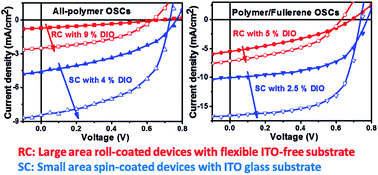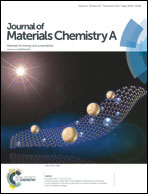Comparison of additive amount used in spin-coated and roll-coated organic solar cells
Abstract
All-polymer and polymer/fullerene inverted solar cells were fabricated by spin-coating and roll-coating processes. The spin-coated small-area (0.04 cm2) devices were fabricated on indium tin oxide (ITO) coated glass substrates in nitrogen. The roll-coated large-area (1.0 cm2) devices were prepared on ITO-free flexible substrates under ambient conditions. The use of a solvent additive, 1,8-diiodooctane (DIO), facilitated phase separation and enhanced power conversion efficiencies (PCEs). The PCE of polymer/fullerene solar cells increased from 4.58% to 8.12% with 2.5% (v/v) DIO when using the spin-coating process, and increased from 1.37% to 2.09% with 5% (v/v) DIO in the roll-coating process. The PCE of all-polymer solar cells increased from 1.44% to 3.51% with 4% (v/v) DIO when employing the spin-coating process. For the roll-coated large area devices the PCE increased from 0.15% to 0.73% with 9% (v/v) DIO. The optimal amounts of DIO, when using the roll-coating process for the two different active layers (5% and 9% respectively) are significantly higher than those for the spin-coating process (2.5% and 4%, respectively), which is ascribed to a fundamentally different drying mechanism.


 Please wait while we load your content...
Please wait while we load your content...